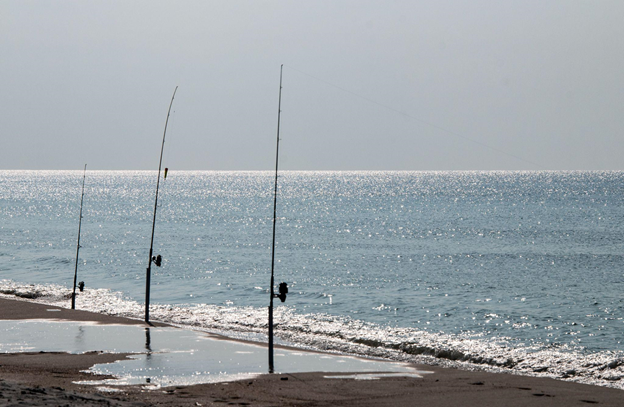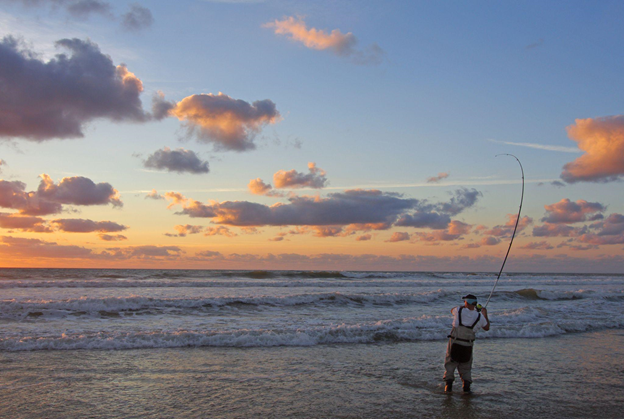Surf Structure: Read the Waves, Find the Fish

In freshwater, we have a saying: wood is good. While this maxim does not seem overtly relatable to surfcasters, the underlying truth is universal: find the structure, and you will find the fish.
Now, in the surf, wood is rarely the structure you will be targeting - although, sometimes, wood does present itself in the form of piers and piles.
But, that said, there is a rich variety of structure in the surf nonetheless, and when you are surf fishing, you will want to know how to work with the structure available to just the same.
Here are some of the major types of structure you’ll encounter in the suds and how to identify it. Pack up your surf casting rod and let’s get to it.
Soft and Hard Structure

First things first, there are two main classes of structure. There is soft structure, which is not physically static, and there is hard structure, that doesn’t change and is more or less fixed in one location.
Sand, currents and thermoclines (boundaries between masses of water of different temperature) are soft structure. Hard structure is effectively anything else. It can be difficult to identify soft structure, too, as it isn’t always visible. Regardless, here are some things to look for.
Types of Structure
-
Pilings and piers: Pilings and piers are perhaps the easiest structure to identify in the surf, as they are static and do not change over time. Bait will often cluster around pilings, especially under piers. Cast your surf fishing lures to this structure, or under it or alongside it, and work the lure as usual. Often you will get thumped.
-
Jetties and rocks: Jetties and rocks, like pilings and piers, will hold bait and shelter predators. Many species of fish, including fluke, tautog, sheepshead, and halibut, will gravitate and then cling to rocks, which harbor plenty of food and safety for them. Target these areas aggressively but be warned - they are usually very snaggy.
-
Sandbars: Sandbars can be either submerged, exposed, or submerged at high tide and exposed at low tide. Either way, sandbars create barriers, channels and troughs which will shelter bait. Oftentimes, bluefish and striped bass will cruise the troughs (see below) on the inside of bars and the deeper water on the outside, following bait up and down the shoreline. Target these areas accordingly.
- Troughs: A trough is a channel of relatively shallow water that either forms between two bars, or more commonly, between a bar and the shore. While relatively shallow, these bars hold plenty of bait and forage in the form of fish and shellfish like surf clams and crabs that all ring a loud dinner bell for predatory fish. While some species will shun the shallows, some inshore fish, like fluke, spot, kingfish, sea robins, skate and dogfish, will all congregate in the troughs.

-
Holes: Holes are isolated areas of deeper water that are usually present fairly close to shore. Because they are submerged, however, they can be difficult to identify. Look for areas of water that appear darker, and over which wave action ceases (waves break over shallow areas). Fish will congregate around holes, as will bait, so work your lures over and around the slopes of holes.
-
Rips: A rip is a type of soft structure that forms when current floods in or out between two bars. Typically the current around a rip is very strong and can cluster and baffle schools of bait. Larger predatory fish will often congregate in and around rips to take advantage of the weary, battered schools of bait in the area. Consequently, metals, plugs and plastics worked aggressively in a rip, to simulate a fleeing baitfish struggling against the current, can be highly effective.
- Points: A point is an area where the beach juts out a little bit. Sometimes they are shallow along the edges, but occasionally there are steeper slopes. If you can find a point that has steeper slopes and is washed out on one side, work your surf fishing lures there. Often, gamefish will hide deep under the slopes on the sides of points for an opportunity to ambush straying bait.
Selecting Surf Fishing Lures
In addition to being able to identify structure in the surf, you will want to make sure you select your surf fishing lures appropriately.
While it is not absolutely critical, a common tactic is to choose a surf fishing lure that closely resembles the primary forage in the area, just as freshwater fishermen do when “matching the hatch.”
For instance, if fish are feeding on eels, diamond jigs and thin soft plastics will be effective. If they are fishing on spearing or bunker, flat spoons or diving plugs will be effective. Poppers can also be effective when targeting predators shacked up around schools of baitfish.
Matching Your Surf Casting Rod to Your Reel, Line and Lures
In addition to curating your selection of surf fishing lures, it is equally important to match your surf casting rod, reel and line to them.
This is critical for BFS anglers, as this is a system in which not just the surf casting rod, but the reel and line are matched precisely to the lures selected.
To keep things simple, you want a rod of appropriate weight, length and action for the lures you choose. Weight is particularly important as very light surf rods will not be able to effectively cast or work very dense, heavy surf fishing lures.
For more information on how to choose a surf fishing rod, see our previous post or get in touch with us directly.
Shop Surf Casting Rods, Gear and Lures Here
Hopefully you found this information on identifying and targeting structure in the surf helpful. Take a quick look through our full collection of surf casting rods, lures and other gear here and if you have any questions on anything in this post or in our collection, reach out to us and we will be more than happy to help.


